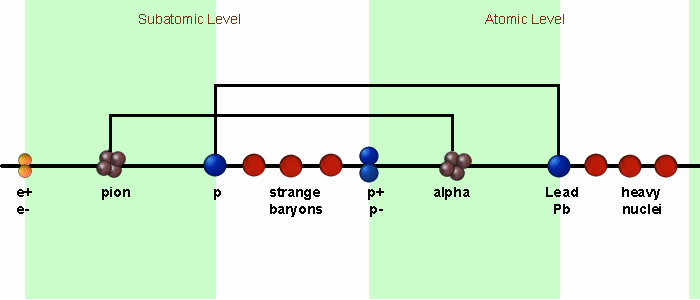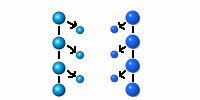The heart of my theory is that the familiar process of alpha radioactivity also occurs at the subatomic level, in the form of the decays of so-called "strange" particles. Another page of this website is dedicated to justifying that. This page shows that, if you accept my theory, we can build up a vision of the underlying granularity of matter and show a pattern repeated between the subatomic and atomic levels.
|
|
First we define the energy levels where an electron-positron pair and a proton-antiproton pair are created as the only two known points of granularity. Something occurs at these energy levels to "lock in" the energy as particle-antiparticle pairs.
|
|
|
Next we add the proton and lead nucleus, and we point out the similarities in their properties...things decay to them and stop there. In the case of lead, it is heavy nuclei that decay by alpha radioactivity. In the case of the proton it is the strange baryons that decay by pion emission.
|
|
|
Then we consider the particles that are emitted in those decays. We observe that the alpha particle and the pion can both be described as being composed of two sets of two oppositely-spinning fermions (with one assumption, that the electron is a charged neutrino). Pions are known to bind nucleons together, and in proton-antiproton annihilations pions are the most common biproduct. It was the identification of protons and neutrons as the components of the alpha particle that paved the way for our understanding of the structure of all nuclei. Similarly, we conclude that the neutrinos that make up the pion are also the constituents of the proton.
Click here for a visualization aid that shows why viewing the pion as a subatomic alpha particle explains the existence of the strange particles.
|
|
|
We next consider the neutron, which decays to a proton, an electron, and an antineutrino, so it doesn't have enough extra neutrinos in its decay products to make a pion. It has a much longer lifespan than the other baryons (15 minutes versus microseconds or less for the others). We look for similarities at the atomic level and see that bismuth, the next heavier element than lead, wouldn't have enough protons in excess of lead to make an alpha particle. We also note that bismuth has the longest half-life of any element (20 billion billion years!). By the way, I predicted to myself, before even knowing which element was next after lead, that whatever it was would have a very long half-life. We are left to wonder if it might decay by emitting one, two or three nucleons, rather than an entire alpha particle. I have more to say about the neutron, but I don't want to break the flow, so I put it at the bottom of the page...read it when you get there.
|
|
|
Continuing on, we can fill in a couple of spaces by observing that kaons decay to two or three pions...we view the kaons as the subatomic equivalent of even proton-numbered elements lighter than lead, which we may consider to be composed of multiple alpha particle units. Note that even z-numbered elements have long been known to be more stable than odd z-numbered ones.
|
|
|
Addressing the low-energy end of the chart, we add the muon between the electron-positron pair and the pion. The muon decays to an electron, an e-type anti-neutrino and a muon-type neutrino, so it is one anti-neutrino shy of a pion. At the atomic level that would be like a 3He nucleus. Counting the electron as a neutrino, the muon has two "root" neutrinos (ones based on the point of granularity) and one "non-root" neutrino, meaning the muon-type. The 3He nucleus has two "root" nucleons, meaning protons, and one "non-root" nucleon, the neutron.
|
|
|
Last, we add the tau particle between heaviest "strange baryon" and the proton-antiproton pair. You'll notice that I haven't connected it to anything, yet. I'll do that on my "predictions and speculation" page, as I show how the supposed mass of the top quark just pops right out! You read that right! I may not believe in quarks, but I can show you why my theory would expect to find a particle at energies associated with the "top quark mass."
|
|
|
|
First, though, I want to say something about leptons in general. Physicists say that as far as they can tell, all three are point particles. And yet the muon and tau decay by emitting neutrinos! It's clear to me that they are composed of neutrinos, but only one of their neutrinos has an electric charge (is an electron). Now, since neutrinos can go right through the entire planet without hitting anything, and when they do detect them scientists need to be underground with a swimming pool full of chemicals, how could they rule out the fact that muons and tau particles have extra neutrinos in them? I think it's time that they stopped seeing the neutrino as a momentum bookkeeping device and start giving it its due. Based on what I am describing here, it's clear that the neutrino is THE fundamental building block of matter.
|
Further thoughts on the neutron: it decays to a hydrogen atom plus an extra anti-neutrino. This has been pointed out often, but usually the anti-neutrino's presence is downplayed, since they treat it as a bookkeeping device. However, if the electron is itself a neutrino, then the neutron's decay products can be thought of as forming a CLOSED SHELL.
|

|
|
That is, a hydrogen atom would be allowed two electrons in its first shell if they had opposite spins. Normally two electrons would repel each other and not be held by the lone proton's positive charge. However, if electrons and neutrinos are interchangeable then there would be nothing to keep one of each such oppositely-spinning fermions (matter-like particles) from merging, since only one has an electric charge. And since the pair form a boson (wave-like particle) there is nothing to stop them from merging with the proton. It is glaringly obvious that the neutron is a "collapsed hydrogen atom with a filled first shell," and this will one day be proven to be the explanation for the neutron's exceedingly long lifespan. What physicists should be exploring is the mechanism by which two oppositely-spinning fermions can merge to form a boson, instead of chasing after quarks. The similarity between a hydrogen atom and a neutron has been known for decades, and yet this whole decay of the neutron is actually DISMISSED in the "standard model," as they say that the neutron and proton are just neutral and charged versions of the same particle!
|
By the way, did you know that the neutron has a magnetic moment? And that it's oriented in the direction associated with a NEGATIVE charge in motion? I don't know what gyrations the quark theory goes through to explain this, but it's certainly not as sweet as viewing the electron/anti-neutrino combination wizzing around inside the proton that make up the neutron's decay products.
|
|
|
|









